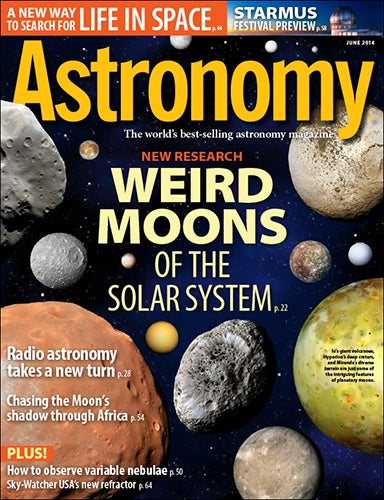
Astronomy offers you the most exciting, visually stunning, thorough, and timely coverage of the heavens above. Each monthly issue includes expert science reporting, vivid color photography, complete sky-event coverage, spot-on observing tips, informative equipment reviews, and more. All of this comes in an easy-to-understand user-friendly style that’s perfect for astronomers at any level. Contact Astronomy, the world’s best-selling astronomy magazine, at 262.796.8776 or email editor@astronomy.com.
WAUKESHA, Wis. – Moons of our solar system have an important place in the history of astronomy beginning when the first ones beyond Earth’s were discovered in 1610. Galileo’s telescopic observations of four of Jupiter’s natural satellites that year ultimately helped confirm that the planets in our solar system orbit the Sun.
But it wasn’t until large ground- and space-based telescopes and exploratory spacecraft started studying the retinue of moons in our planetary neighborhood that astronomers learned how colorful and dynamic these satellites – now 173 and counting – truly are. And what they’ve found is a whole bunch of weird worlds, from a Star Wars satellite and an icy ocean world to a sponge-like celestial body and a moon on fire.
In “Weird moons of the solar system,” author Dean Regas leads a tour of some of these strange places and what makes each so intriguing. “Many of our solar system’s moons are surprisingly dynamic worlds with ongoing geologic activity,” he writes. “Volcanoes blow their tops, liquids flow, and geysers erupt. These objects experience rock tides and display cliff faces like nothing on Earth.”
To learn all about the crazy quirks of 13 of our solar system’s moons, pick up the June issue of
Astronomy, on newsstands May 6.
“The newest big thing in radio astronomy”
Nearly 30 years ago, scientists and engineers began what to some sounded like a crazy plan: to build a radio telescope array of at least 60 antennas that can’t deform more than a third the thickness of a human hair yet are able to survive the elements while moving quickly to different configurations in order to survey the millimeter and submillimeter portions of the electromagnetic spectrum. And on March 13, 2013, the idea came to fruition with the inauguration of the Atacama Large Millimeter/submillimeter Array (ALMA) in Chile’s Atacama Desert. In “The newest big thing in radio astronomy,” learn what it took to get ALMA up and running and the amazing science results it’s already having.
“How to observe variable nebulae”
Backyard observers often turn to objects within our solar system to witness regular changes they can actually see. After all, at such great distances, it’s nearly impossible to watch deep-sky objects move the way relatively nearby planets, moons, asteroids, and comets do. But a certain type of deep-sky target is great for seeing noticeable brightness changes over comparatively short time periods: variable nebulae. In “How to observe variable nebula,” find out how to study these parts of active star-forming regions and start your observing adventure with a recommended list of seven targets.
“Starmus rocks astronomy!”
If you haven’t planned your 2014 vacation yet, you might want to consider the Canary Islands this September if you’d like to take part in one of the greatest astronomy events of the year – and maybe even the past few years. In “Starmus rocks astronomy,” Editor David J. Eicher previews the upcoming Starmus Festival, which takes place September 22–27 and includes talks from Nobel Prize winners, astronauts and cosmonauts, and eminent figures in science, culture, the arts, and music.
June sky events visible without optical aid
June 1 – A waxing crescent Moon joins Jupiter and Mercury in evening twilight.
June 7 – The Moon and Mars pair up in the evening sky.
June 24 – Venus and the Moon dazzle below the Pleiades star cluster in the predawn sky.
June 27 – The June Boötid meteor shower peaks.
Also in the June 2013 Astronomy
- “A new way to search for life in space” – Photosynthesis is arguably the most critical key to life on Earth. Has it happened on other worlds?
- “Chasing the Moon’s shadow through Africa” – Two editors’ adventures offered dramatic scenery and some stunning eclipse vistas.
- “Remote observing takes a giant leap forward” – The iTelescope.Net service provides telescopes, cameras, filters, and more at dark sites, allowing you to acquire images online.
- “Testing Sky-Watcher USA’s new refractor” – A nice package, great performance, and a reasonable price combine to make this 4.7-inch telescope a winner.
- “The Sky this Month” – Exclusive star charts will guide you through June’s night sky.
- The June issue of Astronomy also includes Astro News, Ask Astro, Snapshot, Breakthrough, Bob Berman’s Strange Universe, Stephen James O’Meara’s Secret Sky, Glenn Chaple’s Observing Basics, Erika Rix’s Astro Sketching, Cosmic World, Letters, Web Talk, New Products, Reader Gallery, and Final Frontier.









